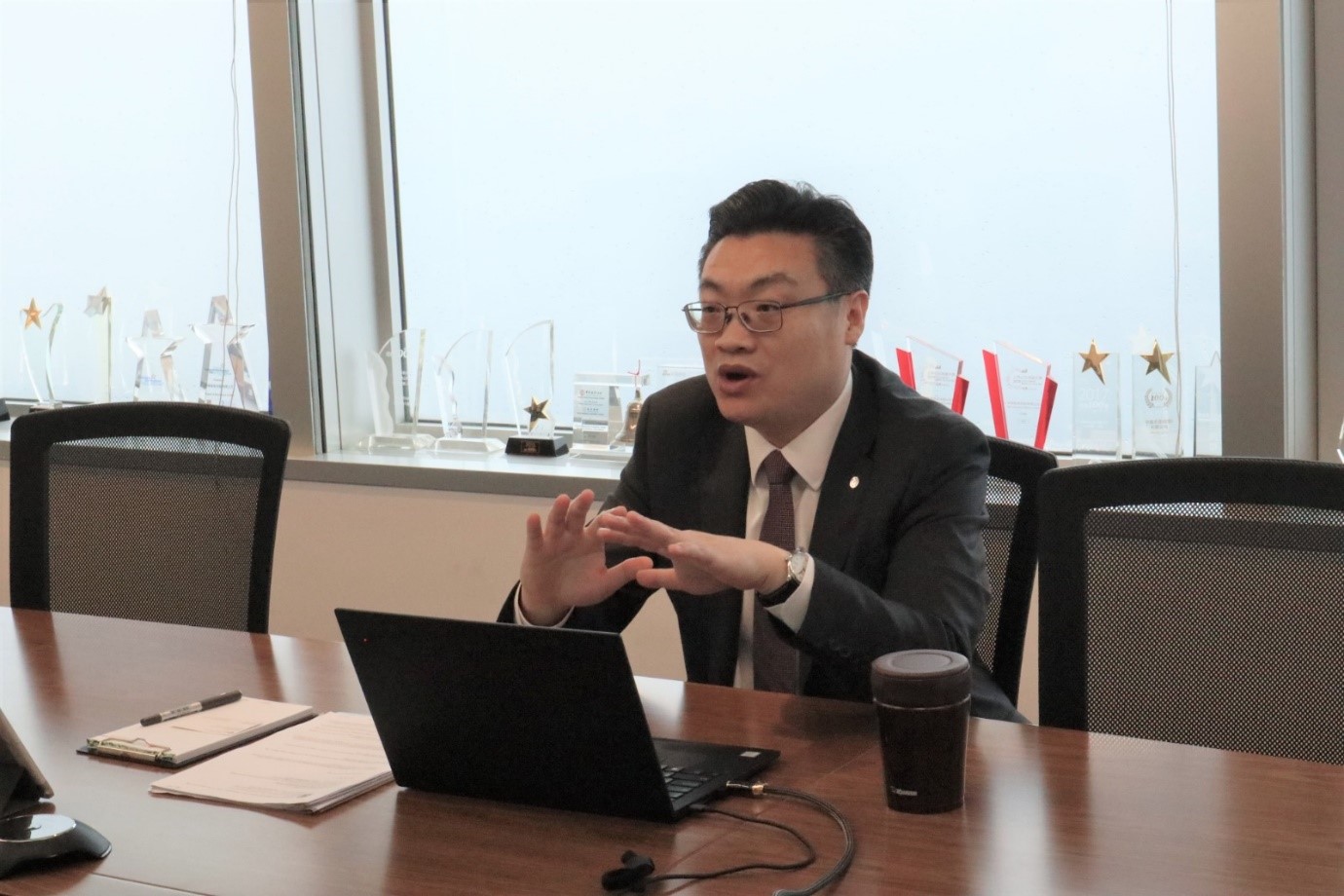Climate Change and Sustainability - Environmental, Social and Governance (ESG) Best Practices brought to you from the Boardroom
By Prof. Lapman Lee, Professor of Practice (ESG, FinTech, Governance), Hong Kong Polytechnic University
Managing Director, Triniton Advisors, specialized in climate change and sustainability governance and risk management, financial and strategic communications
Part 1 (of 5) The Financial Sector - Bank of China (Hong Kong), interview with Mr. Kenny Luo Nan, General Manager, Board Secretary and Company Secretary.

It was a partly cloudy and rainy Friday May 13th when I arrived on the bright and well-lit 53rd floor of the Bank of China Tower and passed the sign “Board Secretariat” to meet Mr. Kenny Luo, Board Secretary and Company Secretary of Bank of China (Hong Kong) Limited (BOCHK), one of Hong Kong’s leading banking groups and the end result of a merger of a dozen banks back in 2001.
Today's interview with the newly elected Council member of the Hong Kong Chartered Governance Institute (HKCGI) is the first of a series of in-depth and in-person ESG interviews with Hong Kong listed companies with the objective 1) to identify best practices in Hong Kong and internationally and 2) to inform the design of an upcoming HKCGI ESG survey to assess the current state of ESG people, process, technology and data capabilities of listed companies in Hong kong, and the real-life challenges and opportunities they face to meet climate change and sustainability requirements from their diverse stakeholder constituents.
In addition to Bank of China (Hong Kong), I will have the opportunity and pleasure to exchange thoughts on the climate change and sustainability strategy with Board members, company secretaries, and chief sustainability officers (CSO) of some of the strongest household names here in Hong Kong.
They include Cheung Kong Hutchison (a diversified conglomerate, whose businesses include ports, retail, infrastructure, and telecom), China Light & Power (energy), MTR (transportation), and New World Development (real estsate development and more) covering all five industry sectors for which the Financial Stability Board’s Task Force on Climate-related Financial Disclosures (TCFD) provided industry-specific supplemental guidance.
TCFD recommendations will be one of the frameworks that the International Sustainability Standards Board (“ISSB”), established as a result of the 2021 UN Climate Change Conference in Glasgow (“COP26”), will use as a foundation for its new proposed standards around general sustainability-related disclosure requirements and specific climate-related disclosure requirements. ISSB will also incorporate industry-based disclosure requirements derived from Sustainability Accounting Standards Board (“SASB”) Standards in a move towards greater harmonization of disclosure requirements
Purpose and sustainability strategy
Let’s start with the overarching purpose of an organization or its “raison d’etre” (literally reason of its existence or license to operate).
“As a subsidiary of state-owned Bank of China operating in Hong Kong and also Southeast Asia, BOCHK plays an important role in achieving and actively supports the China’s net zero emissions target by 2060,” Kenny shares at the outset of our interview, “and as such we have aligned the timeframe of BOCHK’s sustainability strategic plan from a three-year to a five-year plan to be in fully in sync with the country’s 14th five-year plan.”
The Bank’s 2021-2025 sustainability strategy, in essence, defines key objectives under each of the E, S and G pillars.
1. Environmental
- Supporting clients to transition to a low-carbon economy.
- Cultivating regional green finance capabilities.
2. Social
- Building a mutually beneficial society
3. Governance
- Achieving efficient and transparent governance.
“Climate change and the dynamic and ever-increasing stakeholder expectations related to the broader ESG theme may appear to be challenge in terms of resourcing, time and effort, and stakeholder buy-in to prepareyour organization, but for financial institutions like BOCHK it presents also a significant commercial opportunity to 1) assist our clients with their financial services needs as their trusted advisor and financier as they transition to a low-carbon economy, and 2) develop green and sustainable investment products and services to meet increasing market demand and redirect financing towards achieving the United Nations sustainable development goals (“SDGs”),” according to Kenny.

People and Governance
“To me, setting the right tone from the top and strategically communicating and cascading priorities is key to build and sustain the desired culture and mindset,” Kenny emphasizes, “and achieving efficient and transparent governance is both a desired end and a means to an end to achieve our 2021-2025 sustainability strategy.”
BOCHK has a established a three-tier governance structure with a Board level Sustainability Committee to set the overall strategic direction and vision, where 60% of the members are Non-Executive Directors, a Management level Sustainability Executive Committee to translate the strategic direction into strategic initiatives, and an Operational level Sustainability Working Group to execute the strategic initiatives, supported by a Human Resources/ Corporate Social Responsibility Office.
“We have 36 actions as part of our 2021-2025 sustainability strategy, which we incorporated into key performance indicators (“KPIs”) of our management and staff to drive accountability and ownership .”
Regulatory Reporting and Risk Management
I read BOCHK’s 2021 sustainability report to prepare for my interview with Kenny and noted it had been prepared in accordance with the Global Reporting Initiatives (“GRI”) Standards, the ESG Reporting Guide issued by the Hong Kong Exchanges and Clearing Limited (“HKEX”) and the TCFD framework. Prior to 2019 it was called the corporate and social responsibility (“CSR”) report.
There are sustainability reporting frameworks and standards, where frameworks provide principles-based guidance on how information is structured, how it is prepared, and what broad topics are covered. Meanwhile, standards provide specific, detailed, and replicable requirements for what should be reported for each topic, including metrics.
We are seeing that TCFD as a framework is increasingly gaining traction with adoption of its recommendations and supporting disclosures by the HKEX, the Hong Kong Monetary Authority (“HKMA”), the Hong Kong Insurance Authority (“IA”), and the Securities & Futures Commission (“SFC”). The framework, in essence, outlines four thematic areas, i.e. 1) governance, 2) strategy, 3) risk management, 4) metrics and targets for all industry sectors, with supplemental guidance for a number of industry sectors ((a) financial sector, (b) energy, (c) transportation, (d) materials and buildings, (e) agriculture, food & forest products)).
Banks as a subsector of the financial sector (other three being insurance companies, asset owners, asset managers) in three of the four areas:
Strategy - Disclose credit exposure to carbon-related assets, and their climate-related risks, that can be grouped into physical risks, which arise from changes in weather that impact the economy, and into transition risks, which arise from the transition to a low-carbon economy. Risk Management - Identify, monitor, and manage climate-related risks in the context of traditional banking industry risk categories such as credit risk, market risk, liquidity risk, and operational risk.
For small and medium-sized banks with limited budget, resources, time, and often lack of sufficient data and technology, and in-house expertise, it can be a daunting task to identify climate-related risks and opportunities in their banking and trading books.
Metrics & Targets – 1) Identify the metrics used to assess the impact of climate-related risks in the short, medium, and long term, which can relate to credit exposure, equity and debt holdings, or trading positions. 2) Disclose the amount and percentage of carbon-related assets relative to total assets as well as lending and other financing connected with climate-related opportunities. 3) Disclose Greenhouse Gas (“GHG”) emissions, where data and methodologies allow.
For small and medium-sized banks with limited budget, resources, time, and lack of sufficient data and technology, and often in-house expertise, it can be quite a significant effort to identify climate-related risks in the banking and trading books and translate these into relevant insights for management to identify climate-related and sustainability opportunities, products and services.
Metrics & Targets – 1) Identify the metrics used to assess the impact of climate-related risks in the short, medium, and long term, which can relate to credit exposure, equity and debt holdings, or trading positions. 2) Disclose the amount and percentage of carbon-related assets relative to total assets as well as lending and other financing connected with climate-related opportunities. 3) Disclose Greenhouse Gas (GHG) emissions, where data and methodologies allow.
Key take-away: Strategic capability building and expertise
Kenny concludes today’s interview emphasizing the importance of building and investing in strategic and operational capabilities – people incl. governance structure, policies and processes, technology and data – to enable and support the achievement of a financial institution’s sustainability strategy.
Strategic collaboration and partnership between academic (such as Hong Kong Polytechnic University), business, industry association (such as the Hong Kong Chartered Governance Institute) and public sector stakeholders is key to build ESG capabilities and expertise for Hong Kong to unlock its potential as the green and sustainable finance centre of excellence in the Greater Bay Area (“GBA”), China, and the rest of Asia.
| Prof. Lapman Lee | Professor of Practice |
| (ESG, FinTech, Governance), Hong Kong Polytechnic University | |
|
Managing Director, Triniton Advisors, specialized in climate change and sustainability governance and risk management, financial and strategic communications |






